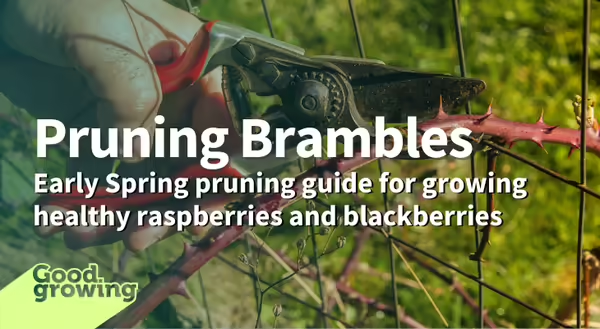
Are you daydreaming of future cobblers, crumbles, jams, jellies, and pies? If you grow your own cane fruit/brambles in early spring, while the plants are still dormant, it is an important time for plant pruning and care. These tasks need to take place before plants leaf out, which means if you haven't yet done so, now is the time! But a raspberry is different than a blackberry, and maintenance varies by crop. Let’s break down early spring maintenance, specifically pruning for our beloved small fruits.
There are three production "systems" for brambles that influence how and when you prune. Each system is divided into red and yellow raspberries, black raspberries and erect blackberries, and semi-erect blackberries. The following methods should work whether your bramble is a primocane fruiting type (where first-year canes bear fruit) or a floricane fruiting type (where second-year canes bear fruit).
Pruning Red and Yellow Raspberries
It is suggested to prune red and yellow raspberries twice per year. The first pruning should take place in early spring, before buds begin to swell. Make your cuts to remove all weak canes, leaving 6 to 8 strong canes per square foot. If you have a trellis to support your red and yellow raspberries, you can cut back the remaining canes to a height of 5-6 feet. For raspberry patches without a trellis, cut slightly shorter at 3-4 feet tall. The second pruning is done after harvest, during which you will remove all the canes that produced fruit that year.
Black Raspberries and Erect Blackberries
These brambles require pruning several times per year. First prune in early spring, before bud growth. Thin the canes by cutting at the base of the stems so that there remain 4-6 canes per hill or canes are spaced 8" apart in a hedgerow. Remove old-fruited canes and weak canes. Tip prune lateral branches of black raspberries back to 8-12 inches tall and purple raspberries and erect blackberries back to 12-18 inches tall. Lateral branches are where fruit will be produced.
During summer, pinch back tips after they have reached a desired height of about 3 feet tall. If trellised, they can grow somewhat taller. This step is essential as all fruit is produced on lateral growth. Tipping back encourages lateral growth. As canes grow, continue to tip back and encourage side-branching.
Semi-erect (thornless) Blackberries
Semi-erect (thornless) blackberries are pruned twice. In early spring, select the best 6-8 canes and prune out weaker ones. Remove any winter-killed canes and any lateral branches up to two feet from the soil line. Cut back the remaining laterals to 12-18" in length. If the cane is too long, cut back to give room to other canes. Second pruning can be done after harvest when you remove canes that have fruited. Because thornless blackberries are not as winter-hardy as thorny blackberries, later pruning is recommended. As new canes develop during the summer, tie them to a trellis support system, as cane growth can reach 12-15 feet in length.
The Rule Breakers
It never fails in nature; there are exceptions to the rules. An example is the primocane-bearing Prime Jim, Prime Jan, and Prime Ark blackberry varieties and fall-bearing raspberries Heritage and Caroline types. The pruning method for late season brambles is very straightforward. Simply mow them off each spring, before bud break, and they will produce a "late summer" crop. This minimizes the amount of pruning required and eliminates the need for trellising.
Good Growing Tip of the Week: Fertilizing of brambles can occur in early spring. A soil test will help guide what nutrients are needed for your situation, however, the rule of thumb is to apply 2 pounds of a 12-12-12 or similar fertilizer per 100 feet of row. For non-suckering brambles (those that grow from a single hill), apply ½ cup per plant.
Sign up for our emails! Want to get notified when new Good Growing posts are available? SIGN ME UP
Give us feedback! How helpful was this information (click one): Very helpful | Somewhat helpful | Not very helpful
MEET THE AUTHOR
Chris Enroth is a horticulture educator with University of Illinois Extension, serving Henderson, McDonough, Knox, and Warren counties since 2012. Chris provides horticulture programming with an emphasis on the home gardener, landscape maintenance personnel, and commercial landscapers. Additional responsibilities include coordinating local county Master Gardener and Master Naturalist volunteers - providing their training, continuing education, advanced training, seasonal events, and organizing community outreach programs for horticulture and conservation assistance/education. In his spare time, Chris enjoys the outdoors, lounging in the garden among the flowers (weeds to most).